In the last post the Real Win Worth (RWW) Assessment was introduced (1). This is a very useful tool for a new product development team to work through early in the development process. The tool asks three key questions related to the proposed new product:
- Is It Real?
- Can We Win?
- Is it Worth It?
In the next three posts we will dive deeper into the details behind these three questions. Let’s start with “Is It Real?’
Market
- How big is the market?
- What is the market growth rate (compound annual growth rate (CAGR)
- What is the total available market?
- Is the market global or local (i.e available only in a local geographic area)
- Who are the key customers?
- What are the market or customers un-met needs? (that is, will the new product be attractive and customers will buy)
- Do you have any strategic partnerships with any key customers?
Technology
- Do you have access to the polymer technology to meet the customer’s unmet needs? (that is, is the new product a new use of an existing technology)
- Can the product be developed using existing resources? (both R&D and manufacturing resources)
- If not, does the technology have to be developed?
- How long would you estimate it would take to develop? R&D resources required?
- Is there another group inside your company that might have the required technology?
- Or can the technology be acquired or licensed from an outside source?
- Do you have any joint development projects with key customers where you can leverage technology development efforts?
At early stages of new product development, you may not have exact data for some of the questions. One of the outcomes is to develop a gap analysis for each project documenting what additional work is necessary to completely answer the questions.
Do the best you can. A good way to work on these is to get the team either in one place or on a conference call. Having sales and marketing, R&D, engineering, and manufacturing resources working together helps to make the exercise more effective. It is common not to have all of the answers readily available, just note that in the action items in the gap analysis. Once the gap analysis is completed for all three questions, assign resources and a timeline to get the additional data needed.
References:
1) George Day, Harvard Business Review, December 2007


Leave a Reply